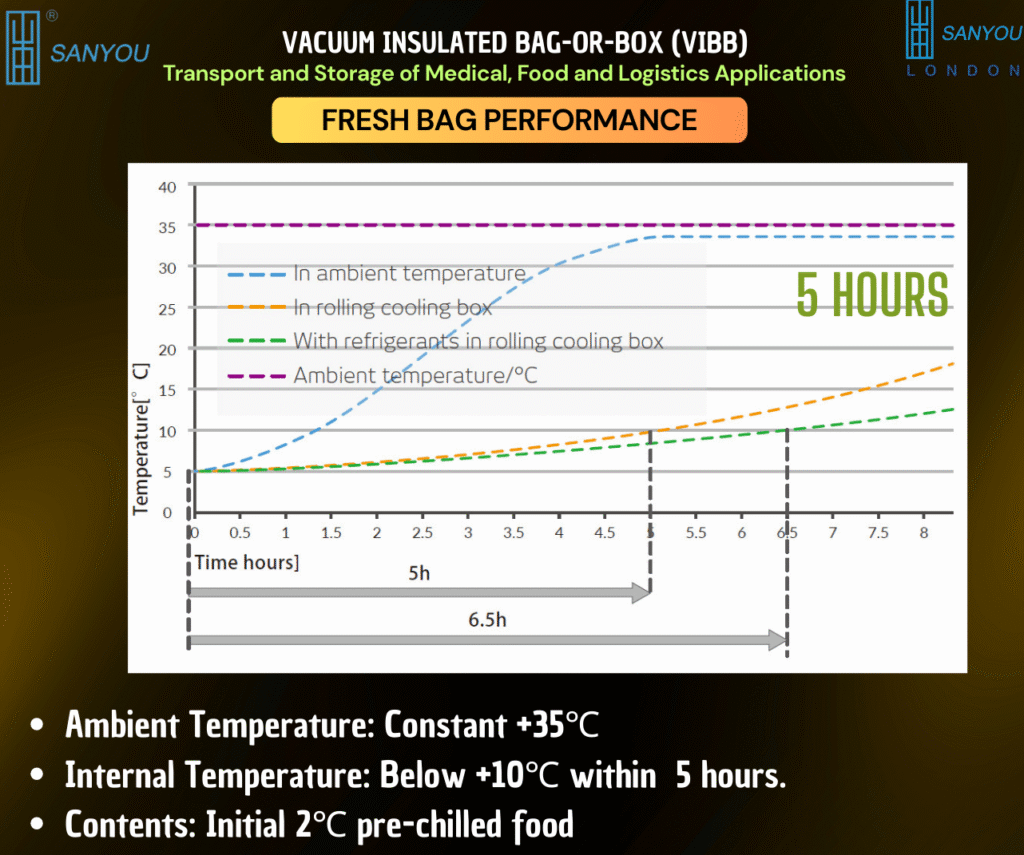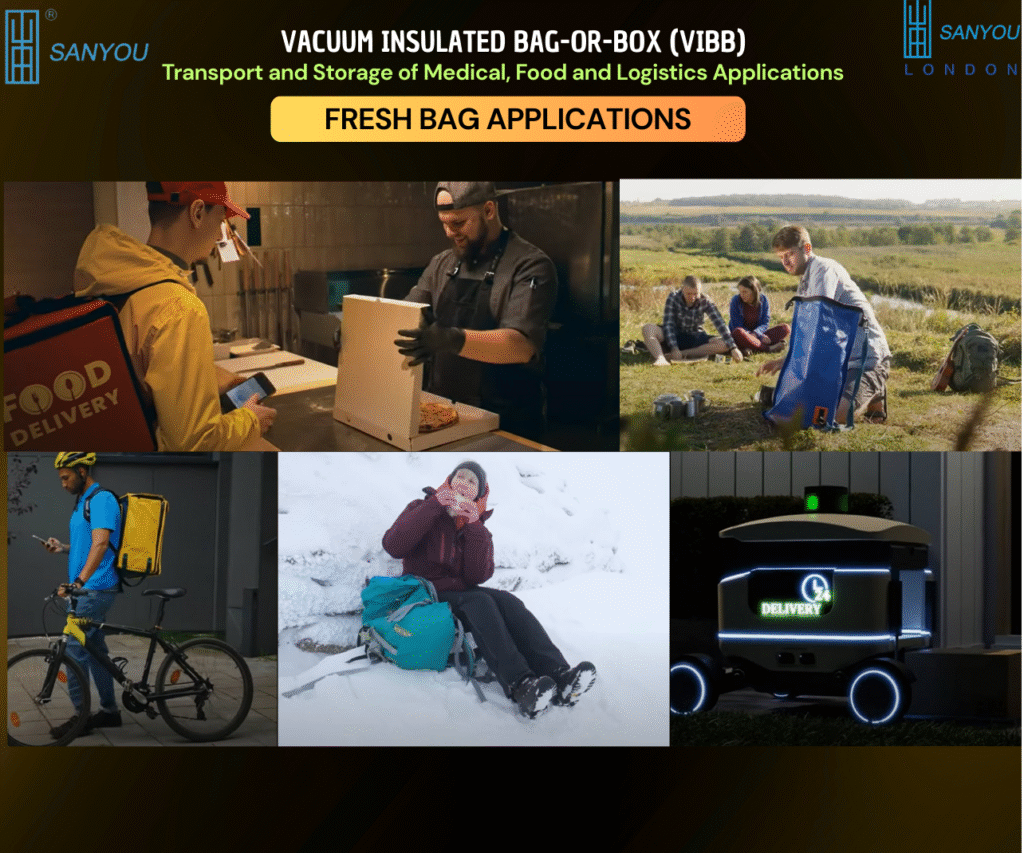
VIBB Fresh Bag: Demonstration, Design, Performance and Applications
Why we manufactured Vacuum Insulated Fresh Bag?
Most cooler bags are foam and fabric; they help for an hour or two, then give up. The VIBB Fresh Bag (Sanyou London) applies vacuum-insulation panel (VIP) technology in a lightweight, everyday carrier—so cold stays cold for a working shift, a long errand, or a day outdoors, without electricity.
Performance—stated plainly
- Hot-day test: at +35 °C ambient, with contents pre-chilled to 2 °C:
- With a rolling cart workflow (frequent open/close): the bag kept the internal temperature below 10 °C for about 5 hours.
- With a small refrigerant/PCM pack and disciplined openings: up to 6.5 hours below 10 °C.
- This is passive cooling; no plugs, fans or dry ice. Duration in your routine depends on load mass, start temperature, opening frequency and packing tightness.

Design that makes the difference
- Thermal core: ultra-thin flexible VIP panels with exceptionally low thermal conductivity, arranged in a quilted architecture to minimise edge losses.
- Shell and liner: tough, wipe-clean outer with a smooth food-safe inner; seams sealed for quick sanitation.
- Closure: full-length zip with storm flap to reduce warm air ingress during quick access.
- PCM sleeve: discreet pocket sized for our phase-change packs when routes or heat waves demand longer hold times.
- Carriage: adjustable shoulder strap plus grab handles; optional rack clips for bikes and e-scooters; D-rings for robot mounts.
- Proofing: integrated data-logger pocket at mid-load height; tamper-evident loop points; clear window for order tickets.
- Sizes: a family of volumes—from compact totes for personal errands to courier-grade bags for multi-drop shifts. All are light, rigid enough to protect the load, and easy to stow.
A simple demonstration you can run tomorrow
Show your team—or yourself—what the bag does in the real world.
Set-up (home or depot):
- Chill a mix of groceries or meal packs to 2–4 °C.
- Place a small PCM pack conditioned to the same band in the sleeve (optional for the 6.5-hour profile).
- Drop a data logger or probe thermometer into the built-in pocket.
- Stage the test space near a sunny window or a warm room (aim for ≥30 °C if possible).
- Run two bags side-by-side: VIBB Fresh Bag vs an ordinary foam cooler, opening both once per hour for 30 seconds to simulate deliveries.
What to expect: the conventional cooler will trend upward quickly; the VIBB trace will rise slowly and steadily, staying under 10 °C far longer, with smaller spikes after each opening.
Applications beyond the obvious

Delivery fleets—riders, drivers and micro-mobility
- Problem: time between store and doorstep varies; hot pavements and idling traffic warm loads.
- Fresh Bag fit: steadier temperatures mean fewer “too warm/too melted” complaints; fewer refunds; better ratings. Rack clips and robot mounts make integration simple.
Autonomous delivery robots
- Problem: small cargo bays, no active cooling.
- Fresh Bag fit: sized inserts create a passive cold pod inside the robot; logger pocket provides verifiable traces for QA.
Everyday living—errands and leisure
- Gym-then-grocery: keep dairy and meat cold in the car park and on the drive home.
- Picnic days: fewer ice-pack hassles; more room for food; easy clean-down.
- Hiking and hilltops: pack chilled snacks—and, with a high-temp PCM, carry warm food to enjoy at the summit.
Corporate and campus hospitality
- Problem: last-metre carry from kitchen to meeting rooms; long walks across sites.
- Fresh Bag fit: quiet, power-free holds for fruit, desserts or boxed lunches—no trolleys, no plug-ins.
Pack-out that protects performance
- Pre-condition: chill the payload properly; a bag can’t fix warm contents.
- Load tight: remove voids with dividers; air is the enemy in a cold bag.
- Open with purpose: plan picks so the zip is open for seconds, not minutes.
- Use the PCM sleeve on hot days or long routes; condition packs to the printed set-point.
- Log the first week: a cheap data logger builds confidence and trains good habits.
Hygiene, durability and sustainability
- Clean-down: smooth liner wipes with neutral detergents; seams are sealed; dries fast.
- Service life: replaceable straps and zipper pulls; serial numbers for asset tracking.
- Waste cut: reusable VIP construction displaces mountains of single-use EPS; fewer spoiled orders reduce food waste and refunds.
Frequently asked (straight answers)
Can it keep food hot?
Yes—swap in high-temperature PCM packs. The same VIP shell slows heat loss; you set the service temperature according to your food-safety plan.
Will it fit our bike racks or car boots?
We supply sizes for common racks and courier boxes; custom brackets are available. For cars, the flat base and compact height fit under parcel shelves.
Is it heavy?
No. VIP gives high resistance without bulky foam; you carry payload, not packaging.
What about rain?
The shell resists showers; for sustained rain, add the optional rain cover.
Choosing the right Fresh Bag
- Rider model: slimmer profile; quick-grab top; optimised for frequent access.
- Courier model: larger volume; reinforced base; ticket window and logger pocket as standard.
- Adventure model: extra strap points; optional hot-food PCM kit; external bottle holster.
Our team can map bag sizes to your order volumes, rack types, and route lengths.
How to buy—and how we support you
- Contact our Customer Service Team for specifications, pack-out tables, sample packs, and tailored price quotations.
- Prefer a direct conversation? Email or phone Professor Saim Memon—we will review your routes, vehicle mounts, and service targets, then propose the right mix of sizes, PCM kits and accessories.
- Explore videos, FAQs and the full VIBB range at www.sanyoulondon.com.
Bottom line: the VIBB Fresh Bag brings laboratory-grade insulation to everyday life—keeping cold food cold (and hot food hot) for hours, quietly, cleanly and reliably, wherever your day takes you.
Share

Author
Prof. Dr. Saim Memon
PhD, CEng, FHEA, MSc, BEng(Hons), PGC-TQFE, GTCS, MCMI, MIET, MIEEE, MInstP, IBPSA, APCBEES, MPEC
CEO | Industrial Professor | Inventor | British Scientist | Chartered Engineer | Qualified Teacher | Chief Editor | World Speaker | Pioneer in Vacuum Insulation Energy Technologies

